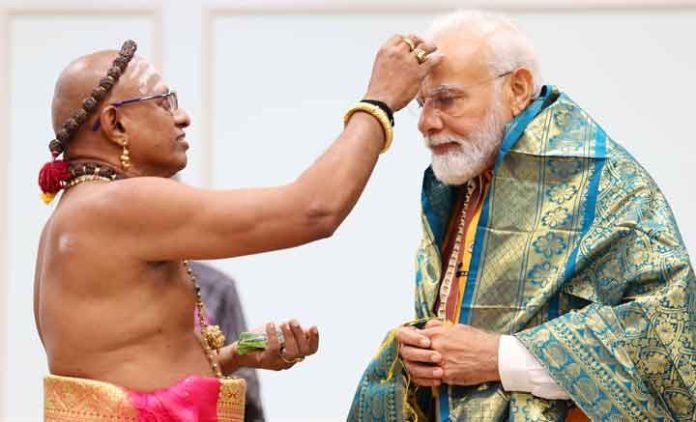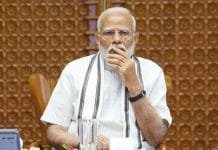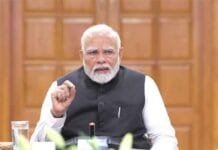INVC NEWS
New Delhi – : In a significant gesture preceding the inauguration ceremony of the new Parliament House, Adhinam Mahant saints from Chennai had the privilege of meeting Prime Minister Narendra Modi at his residence. During the meeting, the Adhinam saints blessed PM Modi and presented him with a symbolic gift known as Sengol. This article delves into the details of this ceremonial handover, shedding light on the historical and cultural significance of Sengol, its relevance as a symbol of power transfer, and the ensuing political controversy.
Adhinam Mahant’s Meeting with PM Modi
A delegation of 21 Adhinam saints, hailing from Tamil Nadu, embarked on a journey to Delhi to participate in the inauguration ceremony of the new Parliament House. Prior to the event, they were granted an audience with PM Modi at his residence. This meeting served as an opportunity for the saints to convey their blessings and good wishes to the Prime Minister.
Handing Over of Sengol to PM Modi
As a token of reverence and goodwill, the Adhinam Mahant saints presented PM Modi with Sengol, a special gift. Sengol, also referred to as a scepter, holds significant cultural and historical importance in Tamil Nadu. The presentation of this ceremonial item to the Prime Minister was accompanied by chants and prayers, creating an atmosphere of sacredness and respect.
The Significance of Sengol in Tamil Nadu Culture
Sengol, a prominent emblem in Tamil Nadu culture, is a symbol of authority and power. It represents leadership, dignity, and the responsibility entrusted to those in positions of influence. Traditionally, the bestowal of Sengol signifies the recognition of an individual’s stature and the acknowledgment of their role in society.
Sengol as a Symbol of Transfer of Power
The historical context surrounding Sengol amplifies its symbolism as a transfer of power. In August 1947, during the pivotal moment of India’s independence, the first Prime Minister, Jawaharlal Nehru, was presented with Sengol as a symbolic gesture. This act marked the formal transfer of power from colonial rule to an independent democratic nation.
Historical Background of Sengol
Sengol holds a rich historical legacy that dates back centuries. Its origins can be traced to ancient Tamil Nadu, where it was used as a regal staff denoting authority. Over time, Sengol became an integral part of religious and cultural ceremonies, symbolizing the divine connection between rulers and their subjects.
The Scepter’s Placement in the New Parliament House
The sengol presented to PM Modi will find its place of honor near the Speaker’s seat in the newly constructed Parliament House. This placement emphasizes the reverence accorded to the symbol and highlights its symbolic role in the functioning of the Parliament. The presence of Sengol serves as a constant reminder of the responsibility and power vested in the elected representatives.
Political Controversy Surrounding the Scepter
The ceremonial handover of Sengol has not been immune to political controversy. The event was marred by the boycott of the opening ceremony by 20 opposition parties, raising questions about the appropriateness and intent behind the inclusion of the symbolic item. The skepticism and dissent surrounding the scepter’s presentation have brought the political landscape into focus, generating debates on the intersection of culture, symbolism, and governance.
Conclusion
The meeting between Adhinam Mahant saints and PM Modi, culminating in the handover of Sengol, serves as a reminder of the deep-rooted cultural traditions and symbolic exchanges that underpin Indian society. The historical significance of Sengol as a symbol of power transfer and the subsequent placement of the scepter in the new Parliament House exemplify the intertwining of culture and governance. However, the political controversy surrounding the event reflects the diverse perspectives and complexities of democratic processes.
FAQs
1. What is the significance of Sengol in Tamil Nadu culture?
Sengol holds cultural significance in Tamil Nadu as a symbol of authority, power, and leadership. It represents the recognition of an individual’s stature and their role in society.
2. When was Sengol first presented as a symbol of power transfer?
Sengol was first presented to Jawaharlal Nehru, the first Prime Minister of India, in August 1947, symbolizing the transfer of power from colonial rule to an independent democratic nation.
3. Where will the Sengol be placed in the new Parliament House?
The Sengol presented to PM Modi will be placed near the Speaker’s seat in the new Parliament House, symbolizing its significance in the functioning of the Parliament.
4. Why did some opposition parties boycott the opening ceremony?
The boycott by opposition parties reflects dissent and skepticism regarding the inclusion of the symbolic item and raises questions about the intersection of culture, symbolism, and governance.
5. How does the handover of Sengol exemplify the intertwining of culture and governance?
The ceremonial handover of Sengol highlights the importance of cultural traditions and symbolic exchanges within Indian society. Its subsequent placement in the Parliament House signifies the connection between culture, governance, and the responsibilities of elected representatives.
















